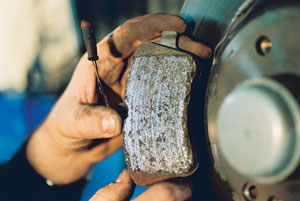By Thomas Hall
Brake pads are one of the few remaining accepted wear items in a modern vehicle. As a result, it represents a significant revenue opportunity for the service and distribution communities.
 Drivers would surely love to have brake pads last for life. Shop owners may have a different opinion. I’m sure that shop owners must deal daily with the question from the customer regarding the life of the pads. How many miles should I get out of a set of pads? Why did they wear out so quickly? Why did my buddy get at least 10,000 more miles on his brakes than I did?
Drivers would surely love to have brake pads last for life. Shop owners may have a different opinion. I’m sure that shop owners must deal daily with the question from the customer regarding the life of the pads. How many miles should I get out of a set of pads? Why did they wear out so quickly? Why did my buddy get at least 10,000 more miles on his brakes than I did?
What determines pad life and how can it be influenced? At its root, the amount of pad wear is established by the particular wear characteristics of the friction material (and rotor), the number of stops and how aggressively the vehicle is braked.
The pad wear rate is established by some standard tests. These tests are conducted on a brake dynamometer. The pad is first run through a burnish and then the brake is subjected to a series of stops at a range of temperatures. The test will run stops at 100 degrees C, 200 degrees C, 300 degrees C and 400 degrees C and then repeated at 100 degrees C. The wear rate at each temperature is established. Generally, the wear at the higher temperatures is significantly more than at lower temperatures.
Wear rate at 400 degrees C can easily be four or more times than lower temperatures. The chemistry of the pad determines the wear characteristic. Semi-metallic materials usually have lower wear rates and less wear sensitivity to temperature than NAO (Non Asbestos Organic) or low metallic classes of materials. On occasion, the brake wear rate can have a sweet spot in the temperature range and actually achieve the lowest wear at the mid-range temperatures.
To complicate matters, the other factor that determines the wear of a pad is the amount of energy it is exposed to. Pad chemistries are used on a broad range of vehicles. As a result, they will be exposed to vastly different energy levels even though the recipe is the same. As a result, trying to compare the wear from one vehicle to another is difficult at best.
At the engineering level, we attempt to standardize the analysis by imposing the pad shape, caliper, rotor and inertia of the vehicle. If all of these factors are consistent, then it is reasonable to compare wear rates between friction materials.
Once the material is selected for the vehicle, the operating temperature of the brake becomes the determinate of the ultimate wear. Operating temperature will be established by the overall thermal capacity of the brake system, the amount of cooling, the brake balance (how much work the fronts do over the rears) and the driving characteristic.
The wear performance of the vehicle is evaluated generally with a city traffic schedule. Popular schedules in the U.S. are Los Angeles and Phoenix. The tests are similar and have been a standard in the industry for a generation. A route through the metropolitan area is established and is generally about 200 miles per day. Normal drivers are used and no special technique is required. These cities are the popular choice due to their high-traffic density (lots of stops) and their generally high ambient temperatures.
Typical tests have a duration of 5,000 miles (or 25 days) and generally run first shift during weekdays to encounter the typical driving conditions. Pads are measured at the beginning of test and end of test. The amount of actual wear is divided by the 5,000 miles and a wear rate is determined. For example, a pad that starts at 10mm thickness and wears to 8mm after 5,000 miles has a wear rate of 2,500 miles/mm. This 10mm pad would have a “Projected Life” of 25,000 miles.
Back to the question at the parts counter: “How long should a pad last?” Like most things in life, the real answer is, “It depends.” A general rule of thumb is that a “normal driver” can expect an approximate pad life of about two times the LA or Phoenix number. Normal usually means somebody who doesn’t live in L.A. or Phoenix. Normal in these cities is about what the test predicts and brake life will generally be in the range of 12,000 to 20,000 miles.
Driving habits can vary widely from individual to individual. As a result, it is unlikely that two people driving the same route in the same car would get equivalent life out of the brake pads.
The traditional service provider will have a much more difficult time sorting out excessive wear problems. A few questions and some good vehicle analysis can often times identify a probable cause:
1. What is the driver comparing his wear too? His buddy? The last set of pads he had? His last car?
2. Have his driving habits changed? Did he move? Get a new job on a different side of town? Has someone else been driving the car significantly?
3. Has the vehicle usage changed? Any evidence of significant loading? What’s in the trunk or bed? Is their a trailer hitch? Is the ball clean or rusty?
4. Confirm all brakes are functioning properly. Are the rear brakes working effectively? Any evidence of drag? Evidence of significant heat at the fronts or rears?
5. Are other parts (tires, shocks, struts and steering) showing significant wear? How about the seat or the pad on the brake pedal?












